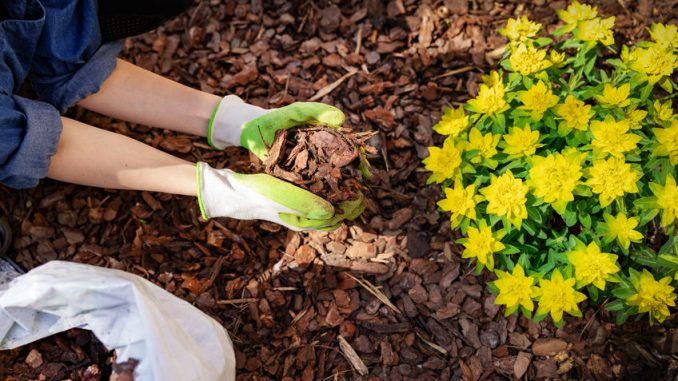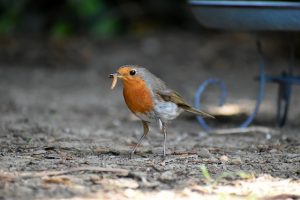
Mulch is the unsung hero in the garden. Whether you are growing vegetables or tending your flower borders and pots, the best thing that you can do for your wildlife garden in April is to mulch!
When done properly, mulching cuts down on the time it takes to water and feed plants. It will also help reduce weeds and plant pests. All in all it makes for healthier plants and reduces use of pesticides and herbicides; all good news for garden wildlife.
Success in your garden begins with your soil. To keep your soil healthy you need to make sure that it has about 5% organic matter.
So what is organic matter?
Soil organic matter is made up of soil organisms (such as fungi, bacteria, protozoa and earthworms) and their food source; dead plant and animal material.
Because the dead plant and animal material is constantly being broken down, adding an organic mulch on an annual basis will make sure that you provide your soil organisms with a healthy level of available food.
Ensuring that you have a rich diversity of soil organisms in your garden is an essential for any serious wildlife gardener. You may hardly ever see them, but you and your garden will certainly reap the benefits of their hard work and they provide an important food source for garden birds.

In this article we consider the different types of mulch, how to choose the best type for your garden and how to apply it properly.
What is Mulch?
Mulch is a thick layer of material placed over the soil and around plants.
There are two kinds of mulch: organic and inorganic. Organic mulches include material such as wood chips, cocoa shells, shredded bark, chopped leaves, straw and compost. Inorganic mulches include plastic landscape fabrics, stone chippings and gravel.
Why is Mulching Beneficial?
Both types of mulch suppress weeds and lock moisture into the soil. They also help to moderate soil temperature, keeping roots healthy.
Cutting down water loss from soil is particularly important for young trees, shrubs and perennials that have been recently planted. After spending your hard-earned cash on plants, it is essential that you don’t let them go short of water in their first year. Mulching is the answer!
Before you add any mulch, it pays to prepare the soil beforehand. This will save you time and effort in the long run. Always weed first and then water thoroughly so the mulch keeps the water in the soil.
If you are using an organic mulch, make sure you have a thick enough layer. You need a depth of four inches to stop new weeds coming through.
Organic mulches also contain nutrients and so have the additional benefit of acting as a slow-release plant food. Because worms take the organic mulch into the soil, it also helps to improve soil structure, meaning that over time your soil will become more moisture retentive.
Organic mulches break down over time and so will need to be replaced regularly. Inorganic mulches don’t break down, so although they are not as attractive to look at, they can offer a longer term solution to weed suppression.

How to Use The Different Types of Mulch.
Organic Mulches:
1.Wood Chips and Shredded Leaves
You can buy wood chips or shredded leaves in bags. If you plan ahead and have a garden shredder, a less expensive option is to make your own.
2. Grass Clippings and Leaf Mould
3. Compost
Making your own compost will provide you with a fantastic all-round mulch.
Home made compost is great for retaining moisture, suppressing weeds and improving soil structure. Rich in nutrients it has the added benefit of acting as a slow-release plant food.
This is the perfect allrounder, providing maximum benefit for your veg plot and flower borders.
4. Straw or Hay
For your veg plot or allotment it is worth considering using a straw or hay mulch. This type of mulch retains soil moisture, prevents weeds, and adds nutrients to the soil when it breaks down. It also looks crisp and clean.
5. Well-rotted Horse Manure
Packed with nutrients and great at retaining moisture, this is a perfect mulch for hungry plants.
Clematis and roses will reward you well if you mulch them with this. It is also a perfect choice for the veg plot, particularly if you are growing courgettes and squashes. Make sure it’s well rotted or it might ‘scorch’ plant leaves.
6. Mushroom compost
This mulch is light and very easy to use, but it contains lime and will raise the pH of your soil, so should be used with caution. It’s ideal for lime-loving vegetables like kale, cabbage and broccoli. Avoid using in your flowers borders if you have acid-loving plants like rhododendrons and camellias.
Inorganic Mulches:
1. Plastic Mulch
This is spread tightly over a smooth soil surface, suppressing weed growth and retaining soil moisture.
Mulching your veg plot with plastic fabric can work wonders; the black plastic warms the soil beneath by as much as 3 degrees, creating a microclimate which boosts growth rates and yields.
Because the plastic fabrics stays warm and dry, it can protect the fruits of plants such as strawberries from rotting and being eaten by slugs.
It is important to bear in mind that some plastic fabrics will disintegrate over time and leach plastic fragments into the soil. Since water and air can’t permeate plastic, you won’t be able to rely on rainwater for hydration and will need to water your plants regularly.
It is important not to use this type of mulch under shrubs. Because water and air cannot penetrate the plastic, shrub roots respond by growing closer to the soil surface as hey seek moisture. These shallow roots struggle to get the water and oxygen they need and, over time, the health of the shrub declines.
2. Rocks or Gravel
Rock or gravel mulches are typically used in pots and gravel gardens, helping to seal in moisture and suppress weeds. Bear in mind that rock or gravel mulches can heat up in the sun and cause the planting area to become too hot for many plants to grow. They’re best used in drought-resistant planting schemes.

To Sum Up
- If you only do one job in your garden during April, make sure it is mulching
- Choose the right mulch for the job
- All mulch retains moisture and suppresses weeds
- Organic mulch has the added benefit of releasing nutrients into the soil and improving soil structure
- Organic mulches will need replacing every couple of years, as they break down in the soil
Most gardens will struggle to generate enough mulch so you will almost certainly need to buy some in.
Because organic mulch products are so bulky, many people don’t bother or spread the mulch too thinly. For me the obvious solution is to order your mulch online and get it delivered straight to your garden.
We have a range of mulch and compost in our shop. Take a look.
This post contains some links to our affiliate marketing partners. Please read our affiliate disclosure.
Leave a Reply